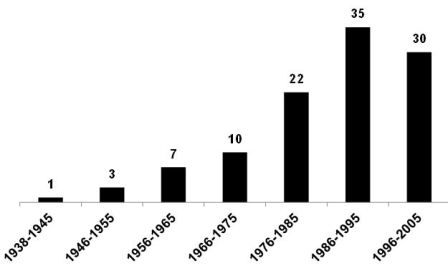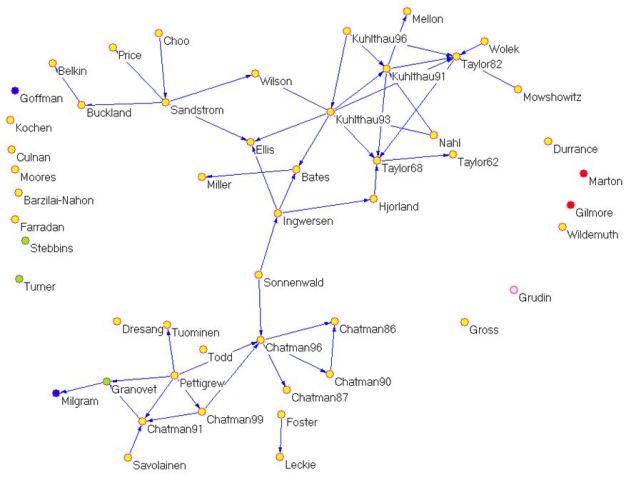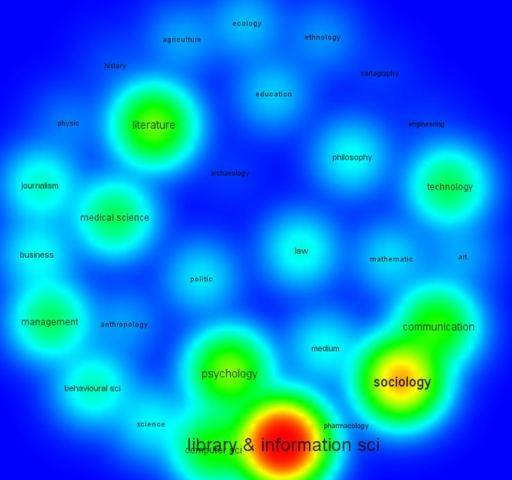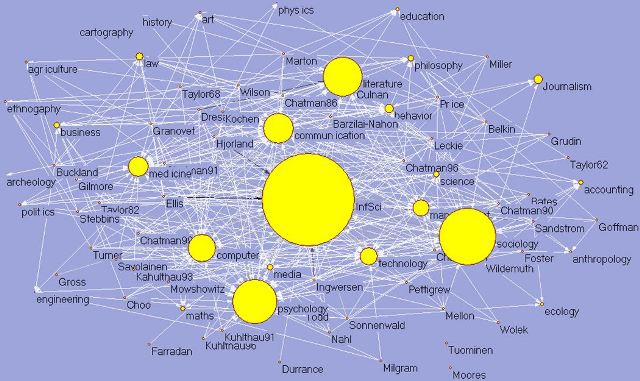
Webology, Volume 10, Number 1, June, 2013 |
| Home | Table of Contents | Titles & Subject Index | Authors Index |
Hamid R. Jamali
Assistant Professor, PhD., Department of Library and Information Studies, Kharazmi University, Tehran, Iran. E-mail: h.jamali (at) gmail.com
Received May 5, 2012; Accepted February 25, 2013
Interrelation of models and theories of human information behaviour (HIB), their common roots, and the extent to which they are indebted to the fields other than library and information science (LIS) were investigated. Fifty-one theories were selected and their bibliographic information was obtained from Web of Science and then citation analysis and bibliographic coupling analysis were performed. Pajek, HistCite, Sci2 Tool and VOSViewer software were used for analysis and visualization. The results showed that most of the theories were proposed by information scientists. A few of the theories were proposed by scientists from the fields of sociology, psychology, computer science and a few other disciplines. Citation analysis showed that LIS literature has been used extensively in HIB theories; however, there were also citations to the sources of 29 other fields especially to sociology, communication, psychology, management, educational science and computer science. This is an indication of the interdisciplinary nature of HIB domain. Bibliographic coupling map showed that about four fifths of the theories were linked to each other as a whole network. The development of a large number of theories within the field of LIS is an indication for the increasing maturity of the interdisciplinary research area of HIB as well as the maturity of LIS field.
Information behaviour; Information seeking behaviour; Theories; Citation analysis; Bibliographic coupling
Information behaviour research is a subject that has been studied at least since the middle of the twentieth century. Since then, the complex and ever changing nature of human information behaviour (HIB) has attracted a large number of researchers from different fields such as library and information science (LIS), psychology, cognitive sciences and computer science and each investigate this area with different aims and from different perspectives. Their studies have produced a rich body of literature whose sheer size is evident from the review presented in Donald Case's book (Case, 2012).
A considerable part of this literature has resulted in models or theories of information behaviour. Models and theories, as Bates says, play an important role in our understanding of phenomena; and models are especially important for the development of theories (2005, p. 3). Models and theories show the elements involved in human information behaviour and help us better understand factors affecting HIB, predict possible future changes in information behaviour and explain interactions of users with information and information systems in different contexts and situations. Therefore, developing models and theories is essential for effectively studying and understanding information behaviour of users. They also make it easy to apply the findings of HIB studies in practice whether in designing an information system or in improving a service. They also form the base for the further study of information behaviour of users. A study by McKechnie and Pettigrew (2002) suggested that the use of theory in the field of library and information science (LIS) had increased.
The number of information behaviour models and theories proposed so far is not exactly known. In 2005, the valuable book 'Theories of Information Behavior' (Fisher, Erdelez, & McKechnie, 2005) came out which in fact was a compendium of about 70 of HIB theories and models. A few years later Houston (2009) also completed their list and provided a list of about 108 theories and models related to HIB in his doctoral dissertation. Having such lists and sources, there is now a better picture of HIB models and theories.
It seems now that the literature of HIB models and theories has reached a critical mass and it still continues to grow and evolve. Although this literature has greatly advanced our knowledge of HIB, our knowledge of the domain itself is not perfect. As Buttlar (1991) mentioned, studying the literature of a field has the benefit of documenting its historical development. Feehan et al. (1987) also maintained that studying a field's literature over time helps that field monitor its progress. This paper sets out to improve our understanding of HIB research domain and its interaction with other fields. The aim is to find out how models and theories of information behaviour are interrelated, whether they have any common roots, and to what extent they are indebted to the fields other than library and information science. The findings not only will help achieve the benefits Buttlar (1991) and Feehan et al. (1987) mentioned, but also will reveal, for example, what other fields contribute to this field so information scientists who work on information behaviour can increase their interactions with those fields.
There is only one study in the literature that is closely related to this research. McKecnnie, Goodall, Lajoie-Paquette, and Julien (2005) did a citation analysis on the HIB literature. Their dataset was 155 English-language HIB articles published from 1993 to 2000 in six prominent LIS journals. Their citation and content analysis showed that HIB literature was cited mainly (81.5%) by LIS authors. Some other fields such as engineering, psychology, education and medicine also cited the HIB literature. Using content analysis, they categorised reasons of citing HIB literature and showed that they were cited generally (36.0%), for findings (28.5%) and for theory (25.3%) with few citations for method (6.0%). They concluded that "HIB literature is yet to have a significant impact on other disciplines. It appears to be a second stage discipline, marked by theoretical consistency and exponential growth in publications and new researchers".
Julien and her colleagues have done three longitudinal studies of information needs and use literature. Julien (1996) covered the articles published between 1990 and 1994. She showed that 20 per cent of the citations were to the literature of fields outside LIS. Julien and Duggan (2000) covered the two periods of 1984-1989 and 1995-1998. They showed that the literature was rather focused inward and relied on work conducted within LIS. Part of the literature was interdisciplinary. The third study (Julien et al., 2011) covered 1999-2008 and it again confirmed the interdisciplinary nature of the information behaviour domain. It also showed that compared to the past, the number of papers by academic researchers compared to papers by information professionals, had increased.
McKechnie and Pettigrew (2002) also studied use of theory in general (and not specifically HIB theories) in the literature of LIS. However, their categorization does not allow us to see how much of use belonged to HIB theories.
Almost two decades have passed since Julien (1996) did her study; and while McKecnnie and her colleagues (2005) focused on what fields cite HIB literature, the current study tries, as one of its aims, to find what fields have been cited by HIB literature. As searches in the literature showed few studies have been done on the HIB literature, and more specially, on HIB theories and models, the current study aims to contribute in this area.
This study is a bibliometric study using citation analysis techniques. Citation analysis is a well-established method for the investigation of interdisciplinary relations as well as for tracking the development of ideas. The list of 108 theories and models of HIB presented in Houston (2009) was used as the base of the study. Each work was searched in ISI Thompson Reuters Web of Science (WoS). Only 51 out of 108 works were indexed in WoS (see the Appendix), therefore the study was restricted to these 51 works and the rest were excluded from the study. The reason for this limitation was that we needed both bibliographic information of the works proposing the theories as well as their cited references for the analysis. Although, WoS might not be a very exhaustive and representative database for this purpose, but there was not a better choice since there are not many citation database available for this field. The researcher did check Scopus in case it included a larger number of theories. But the backfile of Scopus does not go back as much as WoS does and it did not cover a larger number of works. Therefore, WoS was used as the source of data.
The obtained data then were subjected to simple citation analysis, bibliographic coupling analysis, as well as subject analysis of the cited references. The subject categories of journals in which articles were published was used for subject analysis. HistCite (Garfield, 2012), Sci2 Tool (Sci2 Team, 2009), VOSViewer (van Eck and Waltman, 2012) and Pajek (Batagelj & Mrvar, 2009), software packages were used for creating citation historiography, extracting paper-citation network, bibliographic coupling network and the visualization of the networks.
Figure 1 shows publication date of all 108 theories and models listed by Houston (2009). The number of theories has been constantly increasing. Affiliation of the authors of the 51 works included in this study showed that most of them have been authored by American scholars. Thirty-eight of them were by Americans, 5 by British, 3 by Canadians and the rest by some European countries (Denmark, Finland, Sweden, Netherlands & Wales) and Australia.

There are two sources of information for judgement about the subject fields from which the theories originated. One is the discipline of the authors as judged based on their affiliations and the department they worked for, and the other the subject of the journal that published the paper proposing the theory. Table 1 shows the subject origin of the theories based on both of these two sources. LIS accounted for the majority of the theories both in terms of the journals published the works and in terms of the work field of the authors.
| Subject | Affiliation of authors | Subject of journals |
|---|---|---|
| Library and information science | 37 | 43 |
| Sociology and communication | 3 | 3 |
| Psychology and psychiatry | 3 | 2 |
| Computer sciences | 3 | 1 |
| Educational sciences | 2 | 2 |
| Management | 1 | 0 |
| Business and economics | 1 | 0 |
| History of science | 1 | 0 |
The historiography produced by HistCite (Figure 2) shows theories, their publication date and their citation relations. Each node represents a work that has proposed a theory. The list of the works can be found in the Appendix with corresponding node numbers. Arrows link the citing works to the cited ones. Numbers in brackets in front of years indicate the number of works published in that year. The largest number of theories was published in 1991 and 1996, four in each year. The historiography shows that 15 theories have no citation link to the others. These include works such as the ones by Goffman [1], Mooers [2], Farradane [9], Stebbins [15] and Wildemuth [29]. There are also two works that are connected only to each other which is Foster [49] that has cited Leckie [40]. The rest of the works are connected to each other and form a single network with 45 links. Some of the works play an important role in connecting older theories to the more recent ones; these include works by Chatman [27, 39], Ellis [22], Kuhlthau [26, 31], and Wilson [13]. Removing these from the network will break it into a few smaller disconnected components. Figure 3 illustrates the same citation network created with Pajek. Works are categorized into different subjects based on their journal subject. The majority are from LIS (bright, yellow nodes). Grudin (green node) is from computer science, Goffman and Milgram (dark, blue nodes) are from psychology; and Marton and Gilmore (red nodes) are from educational sciences.


In order to see if there are any common roots between different theories, bibliographic coupling network was created. Two works are a bibliographic couple if they both cite a third document. The more common references they have, the stronger the tie or similarity between them. Therefore, we can assume that common references are, in a way, common roots of theories. Figure 4 illustrates network of theories created using bibliographic coupling data. The network data were extracted using Sci2 Tool and the isolated nodes (nodes with no links to others, 12 nodes) were removed and then Pajek was used for visualization. The network includes 39 works. Apart from the three works that form a small isolated network (Dresang, Turner and Barzilai-Nahon) the rest of the works are interconnected. Size of the nodes represents the number of the citations received by that from other works within the dataset (51 works). As it is evident, Taylor (1968), Ellis and Kuhlthau (1998) received more citations. The thickness of the edges indicates the strength of bibliographic coupling relation i.e. number of common references. Apart from the strong link between the works by the same authors (e.g., between Chatman's works, or between Kuhlthau's works), there are strong links between some other works. This network has 39 nodes with 140 edges (links) with average of 3.5 links per node. In terms of the number of links of each node, the most connected works respectively are Kuhlthau (1993) and Savolained each with 17 links, Ellis and Kuhlthau (1991) each with 16 links, Sandstrom and Ingwersen each with 15 links. But in terms of the strongest links (thickest lines), the strongest are the links between Chatman (1991) and Chatman (1990) with the line value of 12 (i.e. 12 common references); and Kuhlthau (1991) and Kuhlthau (1993) (line value = 12); Ingwersen and Kuhlthau (1993) (line value = 11); Kuhlthau (1996) and Kuhlthau (1993) (line value = 9); Bates and Ellis (line value = 9); and Ingwersen and Hjørland (line value = 8). Eighty-eight (62.8%) of the links has the line value of 1.

To see how multidisciplinary the sources of HIB theories are and what subjects' literature have influenced them, subject analyses were conducted on all 2,237 references of the 51 works and they were categorized by subject. Since the information of cited works in WoS does not include the title of the works, this subject categorization was based on the title and subject of the journal in the case of cited journal articles. Searches were also conducted on the Web to find further information when data were not sufficient to determine the subject. In the end, the subject of 49 works could not be determined and the other 2,188 references were categorized into 30 subject categories. Table 2 shows the subjects and the frequency of their references. Figure 5 also visualizes the density of the references using VOSViewer. About 38 per cent of the references belong to LIS field, something expected as a large number of the theories were developed by LIS community. Sociology, psychology, literature, communication, and computer science were the subjects to which HIB theories are indebted most.
| Subject | No. | % | Subject | No. | % |
|---|---|---|---|---|---|
| LIS | 856 | 38.266 | Science General | 21 | 0.939 |
| Sociology | 336 | 15.020 | Accounting | 17 | 0.760 |
| Psychology | 157 | 7.018 | Maths | 17 | 0.760 |
| Literature | 141 | 6.303 | Education | 14 | 0.626 |
| Communication | 109 | 4.873 | Ecology | 12 | 0.536 |
| Computer Sci. | 101 | 4.515 | Agriculture | 9 | 0.402 |
| Medical Sci. | 73 | 3.263 | Anthropology | 8 | 0.358 |
| Technology | 62 | 2.772 | Art | 8 | 0.358 |
| Management | 58 | 2.593 | Politics | 8 | 0.358 |
| Unknown | 49 | 2.190 | Ethnography | 7 | 0.313 |
| Behavioural Sci. | 33 | 1.475 | Engineering | 6 | 0.268 |
| Journalism | 32 | 1.430 | Physics | 5 | 0.224 |
| Law | 27 | 1.207 | History | 2 | 0.089 |
| Philosophy | 23 | 1.028 | Archaeology | 1 | 0.045 |
| Business | 22 | 0.983 | Cartography | 1 | 0.045 |
| Media | 22 | 0.983 | Total | 2237 | 100 |

The next issue is to see how different theories and models have used the literature of different fields. Figure 6 shows citation network of theories and subject literatures. The size of nodes for subject literatures is normalized based on their ratio of total citation received. However, the size of LIS node was intentionally reduced to make the figure more readable. The darker the lines, the larger the number of citations from a given work to a given subject literature. For example, there are strong links between works by Ingwersen, Ellis and Hjørland and LIS literature, and strong link between the work by Dresang and the field of Literature. To get a clearer picture of the relation between theories and different fields, separate graphs were produced for each subject that due to the lack of space are not presented in this paper. What one could understand from the networks is that most of the theories had strong links to the subject of their own field, with some exceptions. For example from the three theories proposed by sociologists, the ones by Stebbins and by Granovetter had cited the literature of sociology but the work by Milgram had no link to the literature of sociology. From the theories originated from LIS fields, works by Chatman had the strongest links with sociology. From the total of 51 works, 23 cited computer science, 5 cited educational sciences, 18 cited management, 26 cited medical sciences, and 10 cited business literature.

This study of citation relations of 51 works that have proposed an HIB model or theory showed that although the first theories in this field were developed by people from fields outside LIS (e.g., Goffman from psychology), LIS researchers have gradually dominated this field. It is said that "the use of theory in scholarly research is a distinguishing characteristic of a discipline's academic maturity" (Hauser, 1988, cited in McKechnie and Pettigrew, 2002, p. 407). One would say that developing theories would be a stronger characteristic of a discipline's academic maturity. The fact that a large number of HIB theories developed within the field of LIS is an indication for the increasing maturity of this interdisciplinary research area as well as the maturity of LIS field.
Moreover, LIS literature has been used extensively in HIB theories. LIS literature accounted for about 38 per cent of the resources used in HIB theories, while this figure was 20 per cent in the study by Julien (1996). But HIB theories have also used resources from at least 29 other fields such as sociology, psychology, communication, education, computer science, medical science, behavioural science, business and management and so on. Some of the works have served as a channel for bringing the influence of other fields to the HIB, such as Chatman's works that by using many resources from sociology helped bring sociological influence to the field of HIB.
Bibliographic coupling and citation analysis showed that some of the works have had a greater citation impact within the domain of HIB theories. Some such as the work by Ellis received more citation and as so, played an important role in linking older theories with more recent ones. Some works such as the one by Ingwersen and Hjørland, or Bates and Ellis had more references in common, which could be an indication of indirect impact of the older on the more recent one.
The overall aim of this study was to help gain a better understanding of the domain of human information behaviour theories. The study showed the multidisciplinary nature of this field with its heavy reliance on the library and information science literature. Although, there seemed to be some relations between theories originating from the fields other than LIS and theories and models from LIS field, there is still need for more collaboration between researchers of different fields. In the last decades there have been attempts for reaching an integrated model of information behaviour (e.g., Bates, 2002; Narayan & Spink, 2008; Lakshminarayanan, 2010). However, reaching a comprehensive and integrated model or theory of information behaviour would be best done by multidisciplinary research. Although this paper shed some light on the relations of the theories, more studies using content analysis and qualitative methods might be needed to better understand the nature of their relations and the way older theories and models have influenced the more recent ones.
One must bear in mind that due to WoS coverage, this study was limited to only 51 (out of 108 theories listed by Houston (2009)) and a more comprehensive and inclusive study is needed to achieve a full picture of HIB theories and their sources. However, even with the current smaller dataset one can see that HIB literature seems to be rich in terms of multidisciplinarity and relatively cohesive in terms of their inter-relations.
This study was funded by Kharazmi University.
List of works in alphabetical order of authors, numbered based on the HistCite graph (Figure 2), with names of the theories in square brackets [].